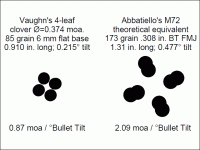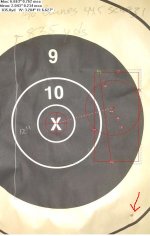My latest method for getting minimal runout
1. Start with new cases or cases that have been resized in a FL non bushing die
2. Perform a 95% skim neck turn using your neck turning tool of choice. I like the Hornady but any will do the trick if properly used
3. Full length resize the case using a non bushing die with the expander button removed. Any FL die will do, even the budget Lee
4. Expand the neck with a mandrel to get your preferred ID for neck tension. I use a Sinclair Gen II mandrel die with Twenty first Century mandrels. Currently the Sinclair is not available for order. However the 21st Century holder is the almost the same price. I prefer mandrels .003 smaller than the bullet diameter for everything. Once again though that is a matter of personal choice, some like more compression some less. They are available in .0005 increments so you could try several if you want.
That is all there is to it. I am getting .001 runout or less on 99.9% of my loads by using this method. I have tried it on .260 Remington, 6.5 Grendel, and 6BRs so far and had great results on all three. Between this and starting to anneal again, I have just about eliminated my "what the heck" flyers on my developed loads
link to 21st century mandrels
http://www.xxicsi.com/caliber-specific-expander-mandrels.html
link to 21st Century expander holder die
http://www.xxicsi.com/expander-die-body.html
You can argue about whether concentricity makes a darn or not but I think
it helps to eliminate flyers. Key word there is think.
1. Start with new cases or cases that have been resized in a FL non bushing die
2. Perform a 95% skim neck turn using your neck turning tool of choice. I like the Hornady but any will do the trick if properly used
3. Full length resize the case using a non bushing die with the expander button removed. Any FL die will do, even the budget Lee
4. Expand the neck with a mandrel to get your preferred ID for neck tension. I use a Sinclair Gen II mandrel die with Twenty first Century mandrels. Currently the Sinclair is not available for order. However the 21st Century holder is the almost the same price. I prefer mandrels .003 smaller than the bullet diameter for everything. Once again though that is a matter of personal choice, some like more compression some less. They are available in .0005 increments so you could try several if you want.
That is all there is to it. I am getting .001 runout or less on 99.9% of my loads by using this method. I have tried it on .260 Remington, 6.5 Grendel, and 6BRs so far and had great results on all three. Between this and starting to anneal again, I have just about eliminated my "what the heck" flyers on my developed loads
link to 21st century mandrels
http://www.xxicsi.com/caliber-specific-expander-mandrels.html
link to 21st Century expander holder die
http://www.xxicsi.com/expander-die-body.html
You can argue about whether concentricity makes a darn or not but I think
it helps to eliminate flyers. Key word there is think.


